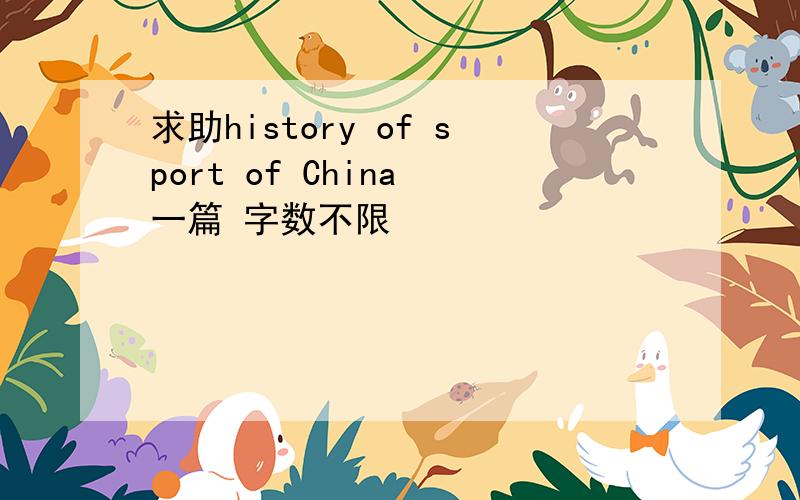求助history of sport of China 一篇 字数不限
来源:学生作业帮助网 编辑:作业帮 时间:2024/12/02 09:29:41

求助history of sport of China 一篇 字数不限
求助history of sport of China 一篇 字数不限
求助history of sport of China 一篇 字数不限
In the Song Dynasty (960-1279), sports games began to develop into popular games and games of entertainment. From Emperor Taizu Kicking a Ju, a painting by the famous Yuan (1279-1368) artist Qian Xuan, we can see Zhao Kuangyin, the first emperor of the Song Dynasty, kicking a ju with his brother
Zhao Kuangyi and some close officials. Ju, a leather ball filled with hair, is a primitive soccer ball. It was so popular in the Song Dynasty that everyone form the emperor to the ordinary people liked it.
Golf is a modern game for the upper class. But in the Yuan Dynasty, the Chinese were already playing a sports game similar to golf, which was painted in Hitting Balls, a mural painting displayed in the museum. At that time people played the game by hitting balls into a hole with a stick crooked at
one end. The one who hit the most balls into the hole won.
Part 3: Minority Ethnic Groups' Sports
The unique Nationalities' Traditional Sports Activities Exhibition hall houses over 300 photos and 500 articles. It enlivens several hundred traditional sports activities of various ethnic groups, which rooted in the history of the ethnic groups, embedded in the local folk customs and mostly
performed in traditional festivals, have been well loved by the native people.
The Mongolian people living on China's northern grasslands are known for their valiance and openness. In August of every year the Mongolians hold the nadam fair, a gala annual meeting in which ethnic sports programs including Mongolian-style wrestling and horse races are performed. Mongolian-style
wrestling differs from wrestling of other ethnicities in that the number of contestants in a Mongolian-style wrestling match must be a power of two and that the contest follows a single elimination system. The contestants wear a wrestling suit decorated with shining copper or silver nails and a
sash made of black, red and yellow cloth. Formal wrestling competitions are held to the accompaniment of singing by old people.
Due to their special living environments, other northern minority people like archery, hunting, wrestling and horse races. In winter, their favorite activities are skating, skiing and sleigh races.
The over 20 minority ethnic groups distributed over Tibet, Yunnan and Guizhou in southwestern China also have special sports programs. Tibetans' favorite sport is the horse race. Their first horse race meeting can be traced back to the year 779, which, lasting half a month, was held to celebrate
the completion of a temple. Today, the Tibetan horse races take three forms: long distance races, short distance jogging and empty horse races. The long distance race is usually held on a straight path six to ten kilometers long, in a pastoral region. Mostly the contestants are boys from 11 to 12
years old. The length for short distance jogging is about three to five kilometers. In a short distance horse race, it is prohibited for horses jump with all four legs simultaneously. The length of the empty horse race is about 10 kilometers.
Today, a national sports meeting of minority ethnic groups is held once every four years, providing an opportunity to train more minority athletes and promoting the development of health-building activities into real sports events.
Editor:Feng Hui
1 2
Emblems More
* Dancing Beijing -- Beijing 2008 Olympic Emblem
* Beijing Paralympics Emblem ( 07-10 )
* Environmental Emblem of Beijing 2008 ( 07-10 )
* Emblem of the Beijing Olympic Torch Relay ( 07-10 )
* Emblem of the Beijing 2008 OYC ( 07-10 )
* Emblem of the Beijing Olympic Cultural Festival ( 07-10 )
News More
* Momentos in time
* Pedal power
* Lighting the way
* Han, the type righting man
* Olympic Games add popularity to Chinese language
Meet in Beijing More
* Latin American Night—From Mayan Civilization to Latin Flavor
* Musical Dreams
* Passing the Baton in Beijing
* Cameroonian Ballet Meets Argentine Tango
* Historical Dance Drama Staged
Olympic on Beijing's Axis
Online Tour
| About us | E-mail | Contact |
Constructed by .cn
Copyright 2003 Ministry of Culture, P.R.China. All rights reserved
chinese language, learning chinese china, HSK, learn chinese writing, learn chinese characters, HSK Exam, chinese school, teach chinese, chinese schools, learn mandarin, learning mandarin, learning chinese, study in chinese, learn chinese abroad, speak chinese, chinese studies, how to learn chinese, learn chinese china, learn chinese online, chinese language online, learn chinese in china, study chinese online, chinese language program, chinese language school, http://www.hellomandarin.com , chinese language schools, chinese speaking, learn chinese, learn mandarin online, learn to write chinese, beijing chinese language school, chinese language china, chinese language classes, chinese language courses, chinese language learning